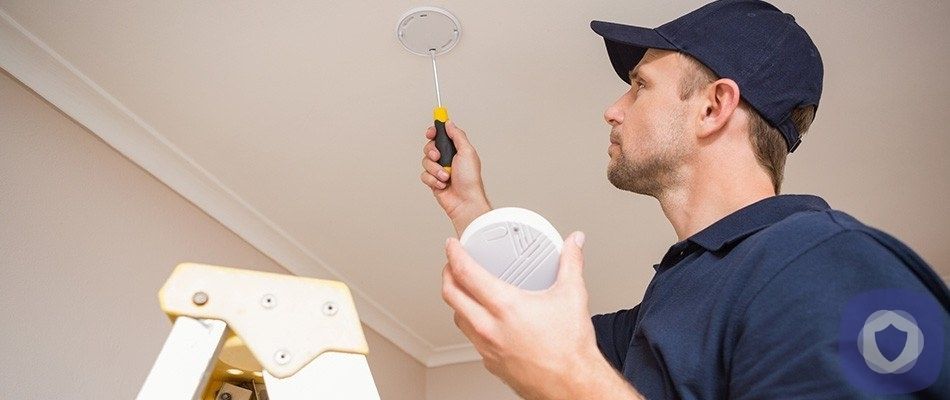Each year, 1,450 fire deaths occur in houses that either had a missing smoke detector or had one without batteries. Although these lifesaving devices are simple to add to your home, people can overlook them or put off installation. Making sure you have smoke detectors is the first step, but knowing where to install them is just as important. Proper installation of your smoke detectors will make all the difference in protecting your home and your family in the event of a house fire.
Here’s where you should install smoke detectors in your home
You should place smoke detectors in specific areas of your home to ensure proper coverage. If you have multiple stories in your home, make sure that they are installed on every floor. Depending on the size and layout of your home, here are the important areas to make sure you have smoke detectors installed:
- Bedrooms: Place a smoke detector in each bedroom. This is important for when you’re sleeping and may not be able to quickly detect a fire. The alarm will wake you up and alert you to danger. Half of all home fire deaths occur when occupants are asleep.
- Kitchen: Install a smoke detector in your kitchen, although make sure to keep it at least 10 feet away from the stove to minimize false alarms. You’ll want smoke detector placement in an area that could be fire-prone and a kitchen is a possible fire source.
- Outside of bedrooms (and hallways): Because smoke may not reach the inside of your bedroom if the fire source is outside, you should consider placing an alarm outside of sleeping areas, particularly in hallways.
- Fireplaces: You should install a smoke alarm around any potential fire sources like a fireplace. Make sure not to place too close to avoid possible false alarms.
- Stairways: Place a smoke detector near a stairway so it can properly alert anyone on other floors of a potential fire.
- Basement: Sometimes this area of the house can be overlooked if it is not as used as the main living area of a home. It is just as important to place smoke alarms in the basement as it is on other floors of your home.
Follow these tips for proper placement
Smoke rises, so place your smoke detectors either high on a wall or on the ceiling. When installing smoke alarms, keep in mind:
- Place alarms within 12 inches of where your ceiling and wall meet.
- Avoid installing them near windows, doors or any place where a draft could impact how it works.
- Don’t paint smoke alarms to fit the wall color. It could impair the functionality.
Make sure to test your smoke detectors for optimal performance
For maximum safety, you should test your smoke detectors once a month. Make it a point on the first day of the month to check if yours are working. Although you should read your manual, generally testing a smoke alarm is as simple as pressing the button down for a few seconds and waiting for the loud alarm to go off. Some alarms come with non-replaceable batteries that last up to 10 years, so make sure to read your model’s instructions.
If the alarm is not quite as loud, or if you happen to hear it chirp repeatedly in your home, it is time for new batteries. As a rule of thumb, you should go ahead and change the smoke detector batteries twice a year. An easy way to make sure you get this done is to change your battery every Daylight Saving Time change. Experts also recommend to replace your smoke detectors every 10 years to ensure proper performance.
Related: Ways to prevent house fires
Decide which type is best for your home
There are three types of different smoke alarms on the market. Consumers can choose between ionization smoke alarms, photoelectric alarms or an alarm that combines the two. Here are the differences between the alarms.
- Photoelectronic: This type of smoke alarm is best at detecting fast moving fires. It uses light to detect fire hazards.
- Ionization: This alarm detectors fires using ionization technology, and is better at detecting smoldering fires with larger particles. These types of fires tend to smolder, and have more smoke and fewer flames.
- Dual sensor alarms: These types of alarms have both photoelectric and ionization technologies. The U.S. Fire Administration recommends either using this type of alarm, or one of each photoelectric and ionization alarms.
Experts recommend buying alarms that can interconnect with each other. This way, if one smoke alarm goes off, then the rest could alert everyone in the home of a possible fire. Having smoke detectors throughout your home can be the difference between life or death for you and your family. In fact, three out of every five deaths in house fires result from properties that did not have working smoke alarms. The risk of dying in a home fire is cut in half if a smoke alarm is present. Purchasing a smoke alarm and knowing where to place smoke detectors will keep your home safe for years to come.
This article has been reviewed and approved by Officer Banta.

Officer Banta is the official SecurityNerd home security and safety expert. A member of the Biloxi Police Department for over 24 years, Officer Banta reviews all articles before lending his stamp of approval. Click here for more information on Officer Banta and the rest of our team.

